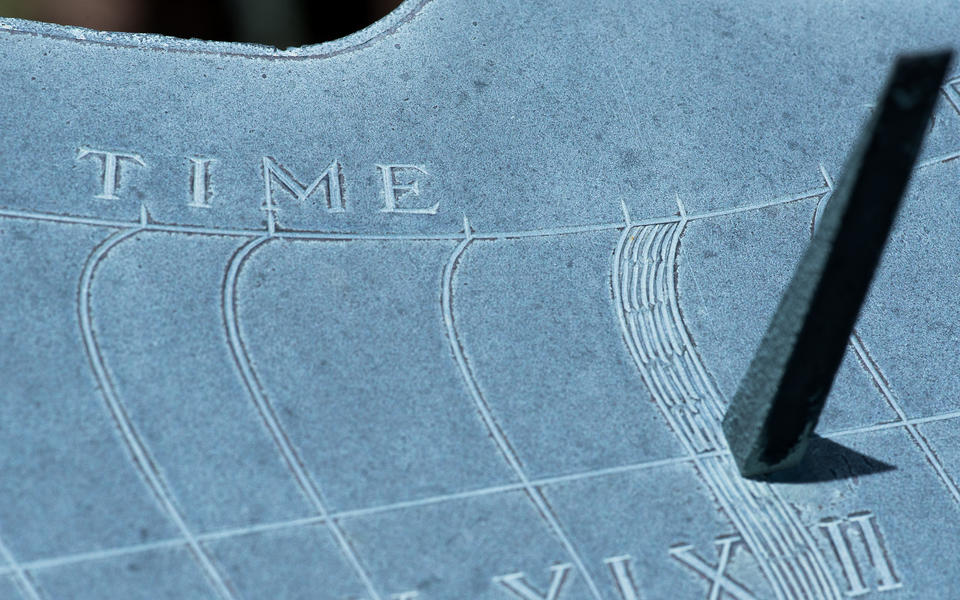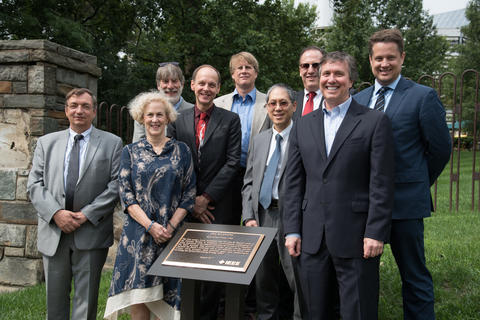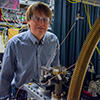Taking Measure
Just a Standard Blog

Detail of a sundial standing in the courtyard at NIST's Gaithersburg, Maryland, campus.
When asked to contribute an essay on some aspect of timekeeping, I had a flashback to the first day of my senior year in high school in Princeton, New Jersey. In AP English, we were assigned to write a single paragraph on something, anything in motion. I made the somewhat curious—and possibly prescient—choice of writing about time. I puzzled over how time moves (what exactly is it that is doing the moving? why does it move in only one direction?) and concluded that, in some sense, time is the ultimate motion, relentless and steady. My English teacher, Mr. Allegretti, said the paragraph was, well, odd, but being a rather odd teacher himself, he found it appealing, and he then even encouraged me to consider expanding it into a longer essay for extra credit.
Well, here I am 37 years later doing just that, and although experimental work toward developing “atomic clocks of the future” has been the focus of my career over the past 30 years, you’ll be happy to know, Mr. Allegretti, that I have spent much of that time writing articles, reports, recommendations, nominations, and now, a personal essay.
I know what it is, but I do not know
From my admittedly biased perspective, time appears to be the most bizarre of our basic units. As St. Augustine remarked, “[w]hat then is time? If no one asks me, I know what it is. If I wish to explain it to him who asks, I do not know.” Indeed, philosophically, time is a slippery creature. Even Einstein concluded, after much thought, that “[t]ime is what clocks measure.”
Whatever time is, for reasons over which I still puzzle, we can measure the passage of time (insofar as time is the accumulation of identical, repeatable events) nearly a million times more precisely than any other physical quantity. In fact, there is a push to redefine as many of our foundational measurement units as possible in terms of time, or its inverse, frequency, to take advantage of our advanced time-measuring capabilities. This explains the mantra intoned in labs around the world: Try to convert whatever quantity you are trying to measure into a frequency.
The reason I believe that the unit of time—the second—is different from its measurement brethren is that, more than the others, time is a human construct. When I see a room full of scientists doing clock comparisons, it can appear as if they are measuring nothing at all—where is this time they are measuring, and why is it represented by electric pulses?
(To be fair, in the lab we often measure frequency, which allows us to make the intangible appear more tangible, even if it is, at its heart, still an illusion.)
I don’t know if animals have an awareness of time beyond their circadian rhythms, but certainly, they sense mass, light, distance and temperature. We humans, however, have found marking the passage of time to be so useful that most of us structure our lives around our timepieces. To create time signals, we turn to repetitive natural processes: the swing of a pendulum, Earth’s orbit around the Sun or Earth’s rotation on its axis. In fact, it was not so long ago that the second was defined “astronomically,” that is, relative to the length of the solar day or even the solar year.
The time of modern times
In more recent times we have exploited the precise oscillation rate of an electron between specific energy levels of an atom. Using atoms as the ultimate pendulum has given us a ticking rate that can be reproduced in principle anywhere in the universe with a precision that is virtually unimaginable on human scales. For instance, the atomic clocks that we use as time standards today do so with such a steadiness that it would not be off by even one second in 300 million years.
(For reference, the average quartz watch might gain or lose about a second every month.)

This year we are celebrating the 50th anniversary of the definition of the standard second as 9,192,631,770 oscillations between the lowest-energy states of atomic cesium. Perhaps coincidentally, in August 2017, the Institute of Electrical and Electronics Engineers (IEEE) installed a plaque in Washington, D.C., and will soon install a copy of that plaque on NIST’s Gaithersburg campus, that commemorates the fact that NIST invented the atomic clock in 1948.
Our next-generation atomic clocks will use visible laser light, which oscillates at approximately 1015 Hz or 1 million billion times a second. These “optical atomic clocks” now achieve a precision to the 18th decimal place (and soon … the 19th!). At this level, the clocks become very sensitive to small changes in gravity. According to Einstein’s general theory of relativity, clocks closer to objects with a lot of mass, such as Earth, run slower, and these effects can be measured by comparing the ticking rates of clocks located at different altitudes. An optical clock built experiment at NIST in 2010 succeeded in distinguishing a difference in the speed at which time passes in two side-by-side clocks varying in height by just 33 centimeters. And recent advances could, in principle, show a difference in ticking rates between clocks separated by only 2 centimeters in height!
In fact, daily fluctuations in the height of Earth’s surface due to volcanism, tectonic shifts, and other factors make it hard to differentiate at a level much finer than 1 centimeter. Because even that small fluctuation would cause these very precise clocks to be off, one day soon we may need to locate our best clocks in space. The idea of an atomic clock circling the globe beaming precise time down to us would be a nice callback to the days when time was defined by the rotation of Earth itself.
Time of the future
Those of us in the metrology world are already preparing a roadmap for a redefinition of the second in terms of an optical atomic transition, roughly a decade from now.
As these clocks achieve ever higher performance, they offer new possibilities. One day, optical clocks may be used for deep-space navigation, ultra-high bandwidth communications, finding oil and mineral deposits, detecting (as hinted at above) and studying changes in the Earth’s surface that could indicate when and where earthquakes or volcanic eruptions are likely to occur, or even a greatly enhanced definition of sea level across our planet.
And because we can measure time so much more accurately than other physical quantities, time offers a unique microscope with which to examine the mysteries of the universe. For example, we foresee networks of future clocks on Earth or in space that will search for signs of gravitational waves, dark matter or flaws in our most fundamental physical theories as we attempt to discover the “new physics” that most scientists believe awaits us beyond the standard model.
These possibilities make it seem, in some sense, that maybe I wasn’t too far off in thinking that time might be the ultimate motion. And as this essay circles back on itself (a feat that time is apparently not permitted to perform), I would like to finish by offering it to my high school English teacher:
Mr. Allegretti, here you are, and thanks for the extension!
About the author
Related Posts
Comments
Has signal form the atomic clock failed? Have not been updated for day Lite savings
Yes it has... My Citizen Atomic Time watch got adjusted from Fort Collins.
From near the limits of reception, in Toronto, Canada....
I am in San Antonio Tx . My watch received the Wwvb signal ok Sunday Am and this Am 0100 cst.
Very nicely written article. Thanks.
If time is a Human Construct, then we humans must endeavour to eliminate time, sometimes.
What happens to our mind, experiences of the universe, Physics and all sciences, when we remove time from equations? What happens to Quantum physics when we remove time.
So, is this experience sans time, the reality and everything else is illusion??
Wonderful questions to ponder about.
In answer to your question, no one can define time. We can only compare two events to two other events. NO?
Off topic, but it's great to see a fellow PHS grad writing about the AP English class.
Around 1910, efficiency experts conducted "time and motion" studies to try to increase the efficiency and output of workers. Thinking about this a few years ago, I realized that without motion there is no time or, perhaps more precisely, no way to measure time. Something has to be moving periodically. In a universe with a single particle, moving in a straight line and not subject to any force, the particle could not tell if it were moving at all, and, if it were rotating (or spinning) uniformly and not subject to any external force, it could
not (having no fixed zero point) count its rotations (or spins) (or even know that it was doing something called "rotating" (or "spinning"). Therefore, I would assert that, in those settings, time doesn't exist—or perhaps it does but is based on a periodic motion that has a "frequency" of zero. In short, therefore, for me time is a measure of motion: no motion, no time. That's it.
(And in the above situation "space-time" would have a space dimension, because it contained a single particle, but it would have no time dimension, since nothing was in detectable motion. Here, therefore, space-time would not exist, only space without time.)
AN EXTENSION OF MY EARLIER SUBMISSION
Around 1910, efficiency experts conducted "time and motion" studies to try to increase the efficiency and output of workers. Thinking about this a few years ago, I realized that without motion there is no time or, perhaps more precisely, no way to measure time. Something has to be moving. In a universe with a single fundamental particle moving in a straight line and not subject to any force, the particle could not tell if it were moving at all, and, if it were spinning (rotating) and not subject to any external force, it could not (having no fixed zero point) count its spins (or even know that it was doing something called "spinning"). Therefore, I would assert that in those settings (especially the first of them) time doesn't exist—or perhaps it does but is based on some periodic motion that has a "frequency" of zero. In short, therefore, for me time is motion: if no motion, then no time—and perhaps no time dimension as well.
In the above situation "space-time" would have a space dimension, because it contained a single particle, but it would appear to have no time dimension, since nothing was in detectable motion. This point is philosophical, however: if motion is not detectable (because there exists no other entity against which to detect its motion), does that preclude there being a time dimension as well as preclude the existence of actual time, per se? If the answer is "yes," then in that circumstance space-time would not exist, only space without time.
If nature, however, has put a second particle (even some "particle" which is a part of the "fabric" of space itself) into the picture, then motion will almost surely occur and a time dimension will apparently appear (if it does not already exist). But here we must make a clear distinction between (1) the "occurrence" of motion and thus the occurrence of a time dimension and (2) determining how much such motion has occurred, using a periodic count to give the original motion a measurable value of a quantity that we call time.
Of course, in the actual universe, even when it began as a point, motion, such as spin, must have been there (since spin is a conserved quantity and, in fact, it does occur now) and, thus, a time dimension must have existed since the appearance of that solitary point, meaning that four-dimensional space time will have existed from the instant of the beginning of our universe and possibly before that.
... And recent advances could, in principle, show a difference in ticking rates between clocks separated by only 2 centimeters in height!
Does this imply (ironically) that one day clocks will perform so well, we will be able to detect differences in tick rates, between clocks at the same height?!
“Time present and time past
Are both perhaps present in time future
And time future contained in time past.”
― T.S. Eliot, Four Quartets
In the end the uncertainty of the measurement will prevail.
Time is the presence of motion and forces. Time is not a dimension. Time is slower where expansion of space is slower as around large masses. Time is caused by the expansion of space. The recent accelerated expansion may be the only clue that our time is actually slowing down. The accelerated expansion is an illusion that is created by our local slowing of time.






To quote the Smothers Brothers (or maybe Mason Williams), who wrote a lot of their stuff:
What has happened to time, doesn't come around any more
The very last time I saw, it was whistling out the door...